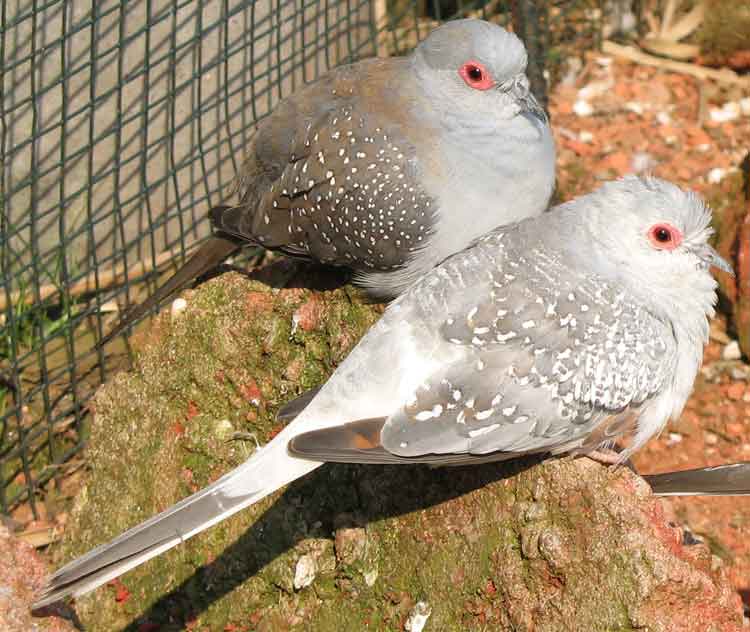Geopelia cuneata (*) Cladus: Eukaryota Name Geopelia cuneata (Latham, 1802) Reference Supplementum indicis ornithologici p.lxi Vernacular names The Diamond Dove (Geopelia cuneata) is a bird resident in Australia. The dove predominantly exists in areas near water but which are lightly arid or semi-arid in nature, being Central, West and Northern Australia. They are one of Australia's smallest pigeons along with the Peaceful Dove. They have been spotted occasionally in Southern Australia in parks and gardens when the centre of Australia is very dry. Description They are small pigeons with a length of 19 to 21 centimetres. Regardless of the gender, they have white spots and black edges on their wings, orange eyes and red eye-rings. The genders look similar except the female's eye ring is less vivid and has more of a brown colour to the plumage. The male's head, neck, and breast are light blue-grey. The bill is a dark grey colour. The abdomen is a creamy colour while the back and tail is a brown-grey colour. The legs and feet are pink. The juveniles have a light grey bill; the iris and eye ring is fawn in colour; the feet and legs are grey; the breast is grey and they do not possess any white spots on their wings. Behaviour The Diamond Dove can often be seen on the ground with a toddling run. Their flight is strong and direct and can be undulating. The wings can make a whistling "frrr" noise when flying. Diamond doves tend to be seen in pairs or small groups feeding off the ground. They feed off seed mostly from grasses. They will also eat ants. The doves tend to breed after rain but mostly in spring in Southern Australia. nests are usually built from interwoven grasses and/or twig. They are of fragile construction. Two white eggs are usually laid and incubated for 13 to 14 days. Chicks are usually fully feathered and flying by two weeks. They are known to have a variety of calls. The calls sound mournful, slow and have a falsetto quality to them. Two calls consist of two long coos followed by a pause and then a long, short and long coo. Sometimes they call two long coos. The alarm coo consists of a few short but loud coos. Conservation Australia Diamond Doves are not listed as threatened on the Australian Environment Protection and Biodiversity Conservation Act 1999. State of Victoria, Australia * The Diamond Dove is listed as threatened on the Victorian Flora and Fauna Guarantee Act (1988).[1] Under this Act, an Action Statement for the recovery and future management of this species has not been prepared.[2] * On the 2007 advisory list of threatened vertebrate fauna in Victoria, the Diamond Dove is listed as near threatened.[3] In captivity Diamond doves can be kept and bred well in captivity and some lines have been bred for so many generations as to be considered domesticated. They spend a considerable amount of time on the ground and require a wide area to walk around. Wire-bottomed cages are not desirable; also, the floor of the cage should be kept clean since they will be walking on it. The cage should also contain perches spaced widely enough for the bird to fly safely. Diamond doves should be encouraged to eat a variety of greens and vegetables in addition to their seed diets. They swallow seeds whole and should be given access to grit to help digest the seeds. In winter, the birds suffer in cold and should not be placed near drafts; a heating pad or basking rock (such as those sold in pet stores for lizards) can be used as a supplemental heat source, and is greatly enjoyed by many diamond doves. Diamond doves build nests in open scoops, and will appreciate open-topped nest baskets. They will nest in whatever they find, however, including the seed dish. The mating behavior begins with a repeated call, usually by the male but sometimes by a female if kept singly. The male will display his tail feathers by dipping his head low and raising his tail, spreading the long feathers like a fan towards a desired female while uttering a two-note coo. The pair will stay together for long periods, greeting each other with low coos and vibrating their wings, or symbolically preening each other with rapid light pecks. Generally, they must live in pairs or flocks, as their need for companionship is high. Single diamond doves can bond to humans if acquired when relatively young, but this requires a commitment of time and attention from the owner because they require months or years to tame and will then require significant companionship time with their owner, much like a parrot. Once tamed, the dove is a sweet and gentle pet, who greets its owner with happy coos and will perch on the finger or shoulder. They will also preen their owner with rapid light pecks, and accept being stroked gently in return. Care must be taken to avoid the bird thinking of its owner as a mate, as this leads to egg-laying and excessive dependence on its owner's companionship, and is stressful to the bird. This can be avoided by not being affectionate with the bird while it is engaging in nesting or display behaviors. References 1. ^ Department of Sustainability and Environment, Victoria * BirdLife International (2004). Geopelia cuneata. 2006. IUCN Red List of Threatened Species. IUCN 2006. www.iucnredlist.org. Retrieved on 12 May 2006. Database entry includes justification for why this species is of least concern Source: Wikipedia, Wikispecies: All text is available under the terms of the GNU Free Documentation License |
|

